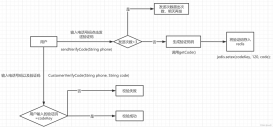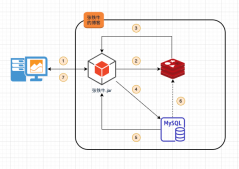引入 Redisson
|
1
2
3
4
5
|
<dependency> <groupId>org.redisson</groupId> <artifactId>redisson-spring-boot-starter</artifactId> <version>3.14.1</version></dependency> |
初始化 Redisson
|
1
2
3
4
5
6
7
8
9
10
11
12
13
14
15
16
17
18
19
20
21
22
|
@Configurationpublic class RedissonConfiguration { // 此处更换自己的 Redis 地址即可 @Value("${redis.addr}") private String addr; @Bean public RedissonClient redisson() { Config config = new Config(); config.useSingleServer() .setAddress(String.format("%s%s", "redis://", addr)) .setConnectionPoolSize(64) // 连接池大小 .setConnectionMinimumIdleSize(8) // 保持最小连接数 .setConnectTimeout(1500) // 建立连接超时时间 .setTimeout(2000) // 执行命令的超时时间, 从命令发送成功时开始计时 .setRetryAttempts(2) // 命令执行失败重试次数 .setRetryInterval(1000); // 命令重试发送时间间隔 return Redisson.create(config); }} |
这样我们就可以在项目里面使用 Redisson 了。
编写 Redisson 分布式锁工具类
Redis 分布式锁的工具类,主要是调用 Redisson 客户端实现,做了轻微的封装。
|
1
2
3
4
5
6
7
8
9
10
11
12
13
14
15
16
17
18
19
20
21
22
23
24
25
26
27
28
29
30
31
32
33
34
35
36
37
38
39
40
41
42
43
44
45
46
47
48
49
50
51
52
53
54
55
56
57
58
59
60
61
62
63
64
65
66
67
68
69
70
71
72
73
74
75
|
@Service@Slf4jpublic class LockManager { /** * 最小锁等待时间 */ private static final int MIN_WAIT_TIME = 10; @Resource private RedissonClient redisson; /** * 加锁,加锁失败抛默认异常 - 操作频繁, 请稍后再试 * * @param key 加锁唯一key * @param expireTime 锁超时时间 毫秒 * @param waitTime 加锁最长等待时间 毫秒 * @return LockResult 加锁结果 */ public LockResult lock(String key, long expireTime, long waitTime) { return lock(key, expireTime, waitTime, () -> new BizException(ResponseEnum.COMMON_FREQUENT_OPERATION_ERROR)); } /** * 加锁,加锁失败抛异常 - 自定义异常 * * @param key 加锁唯一key * @param expireTime 锁超时时间 毫秒 * @param waitTime 加锁最长等待时间 毫秒 * @param exceptionSupplier 加锁失败时抛该异常,传null时加锁失败不抛异常 * @return LockResult 加锁结果 */ private LockResult lock(String key, long expireTime, long waitTime, Supplier<BizException> exceptionSupplier) { if (waitTime < MIN_WAIT_TIME) { waitTime = MIN_WAIT_TIME; } LockResult result = new LockResult(); try { RLock rLock = redisson.getLock(key); try { if (rLock.tryLock(waitTime, expireTime, TimeUnit.MILLISECONDS)) { result.setLockResultStatus(LockResultStatus.SUCCESS); result.setRLock(rLock); } else { result.setLockResultStatus(LockResultStatus.FAILURE); } } catch (InterruptedException e) { log.error("Redis 获取分布式锁失败, key: {}, e: {}", key, e.getMessage()); result.setLockResultStatus(LockResultStatus.EXCEPTION); rLock.unlock(); } } catch (Exception e) { log.error("Redis 获取分布式锁失败, key: {}, e: {}", key, e.getMessage()); result.setLockResultStatus(LockResultStatus.EXCEPTION); } if (exceptionSupplier != null && LockResultStatus.FAILURE.equals(result.getLockResultStatus())) { log.warn("Redis 加锁失败, key: {}", key); throw exceptionSupplier.get(); } log.info("Redis 加锁结果:{}, key: {}", result.getLockResultStatus(), key); return result; } /** * 解锁 */ public void unlock(RLock rLock) { try { rLock.unlock(); } catch (Exception e) { log.warn("Redis 解锁失败", e); } }} |
加锁结果状态枚举类。
|
1
2
3
4
5
6
7
8
9
10
11
12
13
14
|
public enum LockResultStatus { /** * 通信正常,并且加锁成功 */ SUCCESS, /** * 通信正常,但获取锁失败 */ FAILURE, /** * 通信异常和内部异常,锁状态未知 */ EXCEPTION;} |
加锁结果类封装了加锁状态和RLock。
|
1
2
3
4
5
6
7
8
|
@Setter@Getterpublic class LockResult { private LockResultStatus lockResultStatus; private RLock rLock;} |
自此我们就可以使用分布式锁了,使用方式:
|
1
2
3
4
5
6
7
8
9
10
11
12
13
14
15
16
17
18
19
20
|
@Service@Slf4jpublic class TestService { @Resource private LockManager lockManager; public String test(String userId) { // 锁:userId, 锁超时时间:5s, 锁等待时间:50ms LockResult lockResult = lockManager.lock(userId, 5000, 50); try { // 业务代码 } finally { lockManager.unlock(lockResult.getRLock()); } return ""; }} |
为了防止程序发生异常,所以每次我们都需要在finally代码块里手动释放锁。为了更方便优雅的使用 Redis 分布式锁,我们使用注解方式实现下。
声明注解 @Lock
|
1
2
3
4
5
6
7
8
9
10
11
12
13
14
15
16
17
18
19
|
@Target(ElementType.METHOD)@Retention(RetentionPolicy.RUNTIME)public @interface Lock { /** * lock key */ String value(); /** * 锁超时时间,默认5000ms */ long expireTime() default 5000L; /** * 锁等待时间,默认50ms */ long waitTime() default 50L;} |
注解解析类
|
1
2
3
4
5
6
7
8
9
10
11
12
13
14
15
16
17
18
19
20
21
22
23
24
25
26
27
28
29
30
31
32
33
34
35
36
37
38
39
40
41
42
43
44
45
46
47
48
49
50
51
52
53
54
55
56
57
58
59
60
61
62
63
64
|
@Aspect@Component@Slf4jpublic class LockAnnotationParser { @Resource private LockManager lockManager; /** * 定义切点 */ @Pointcut(value = "@annotation(Lock)") private void cutMethod() { } /** * 切点逻辑具体实现 */ @Around(value = "cutMethod() && @annotation(lock)") public Object parser(ProceedingJoinPoint point, Lock lock) throws Throwable { String value = lock.value(); if (isEl(value)) { value = getByEl(value, point); } LockResult lockResult = lockManager.lock(getRealLockKey(value), lock.expireTime(), lock.waitTime()); try { return point.proceed(); } finally { lockManager.unlock(lockResult.getRLock()); } } /** * 解析 SpEL 表达式并返回其值 */ private String getByEl(String el, ProceedingJoinPoint point) { Method method = ((MethodSignature) point.getSignature()).getMethod(); String[] paramNames = getParameterNames(method); Object[] arguments = point.getArgs(); ExpressionParser parser = new SpelExpressionParser(); Expression expression = parser.parseExpression(el); EvaluationContext context = new StandardEvaluationContext(); for (int i = 0; i < arguments.length; i++) { context.setVariable(paramNames[i], arguments[i]); } return expression.getValue(context, String.class); } /** * 获取方法参数名列表 */ private String[] getParameterNames(Method method) { LocalVariableTableParameterNameDiscoverer u = new LocalVariableTableParameterNameDiscoverer(); return u.getParameterNames(method); } private boolean isEl(String str) { return str.contains("#"); } /** * 锁键值 */ private String getRealLockKey(String value) { return String.format("lock:%s", value); }} |
下面使用注解方式使用分布式锁:
|
1
2
3
4
5
6
7
8
9
|
@Service@Slf4jpublic class TestService { @Lock("'test_'+#user.userId") public String test(User user) { // 业务代码 return ""; }} |
当然也可以自定义锁的超时时间和等待时间
|
1
2
3
4
5
6
7
8
9
|
@Service@Slf4jpublic class TestService { @Lock(value = "'test_'+#user.userId", expireTime = 3000, waitTime = 30) public String test(User user) { // 业务代码 return ""; }} |
到此这篇关于如何使用注解方式实现 Redis 分布式锁的文章就介绍到这了,更多相关Redis 分布式锁内容请搜索服务器之家以前的文章或继续浏览下面的相关文章希望大家以后多多支持服务器之家!
原文链接:https://juejin.cn/post/7122042440621490212















